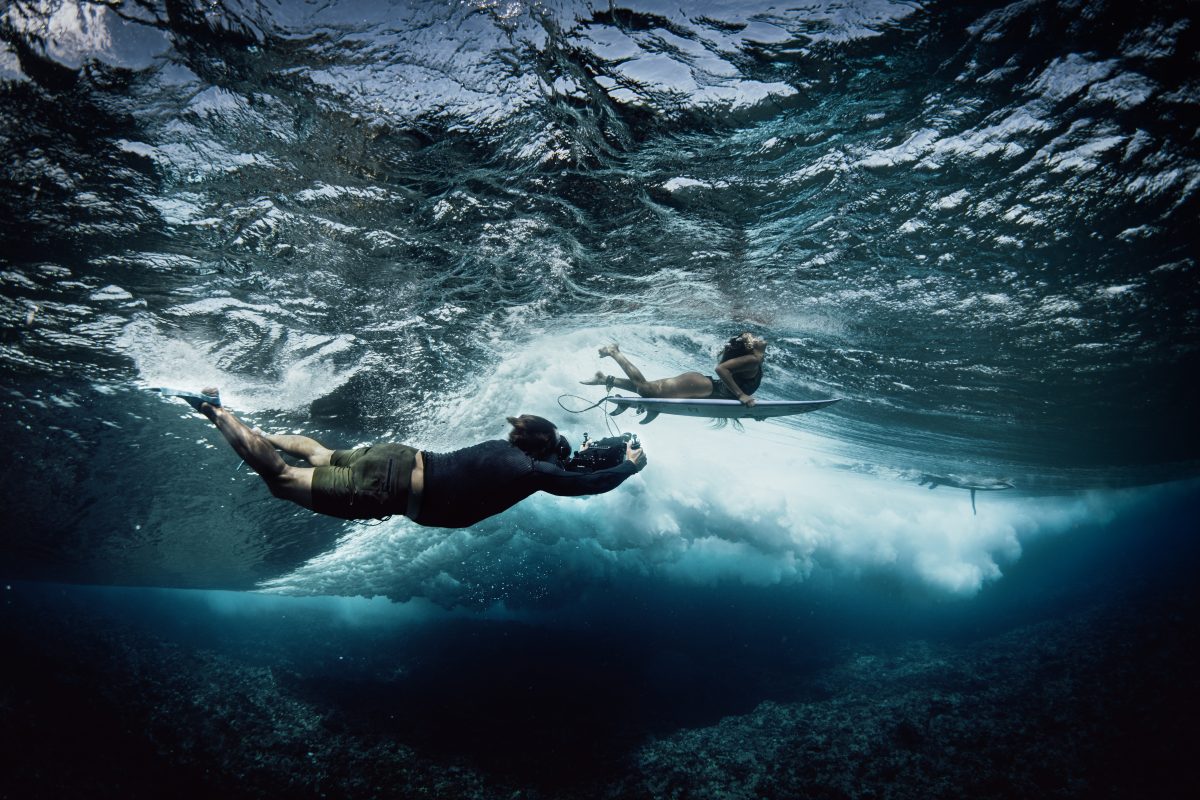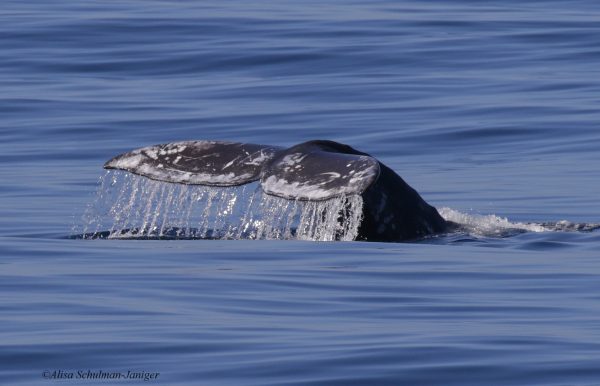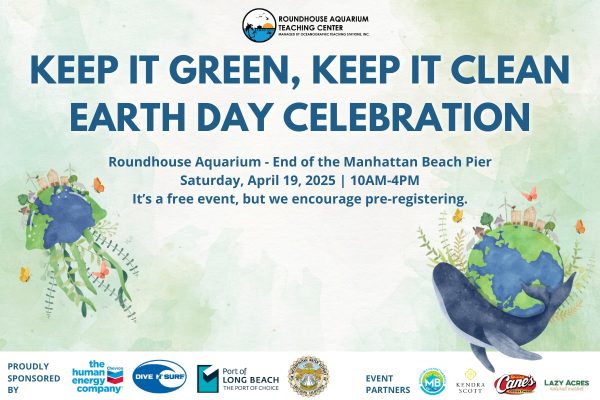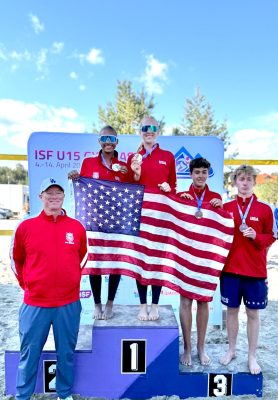by Mark McDermott
It began, like so many harrowing adventures do, with a small group of party crashers.
Action photographer Bo Bridges, who is based in Manhattan Beach but spans the globe for photo shoots, was in Salt Lake City for the 2023 NBA All-Star game. Bridges was at the event mainly for fun. His running crew that day was former Olympian and X Game champion snowboarder Shaun White and the rapper Travis Scott, who’d appeared together at a snowboarding exhibition earlier that day. They found out about an All Star Game afterparty at the University of Utah and just showed up. Though none were on the list, they just cruised on into the party. Celebrity status requires no invitation.
While his famous friends hobnobbed, Bridges was standing there taking in the red carpet scene when somebody called his name. It was Jeb Terry, the president and CEO of Cosm, a cutting-edge, immersive entertainment technology whose research and development facility is at the University of Utah’s Research Park. In fact, that is why the NBA party was at this location. Cosm was unveiling what it could do with NBA footage on its 65-foot tall, 20 meter wide domed “Experience Center” at the university.
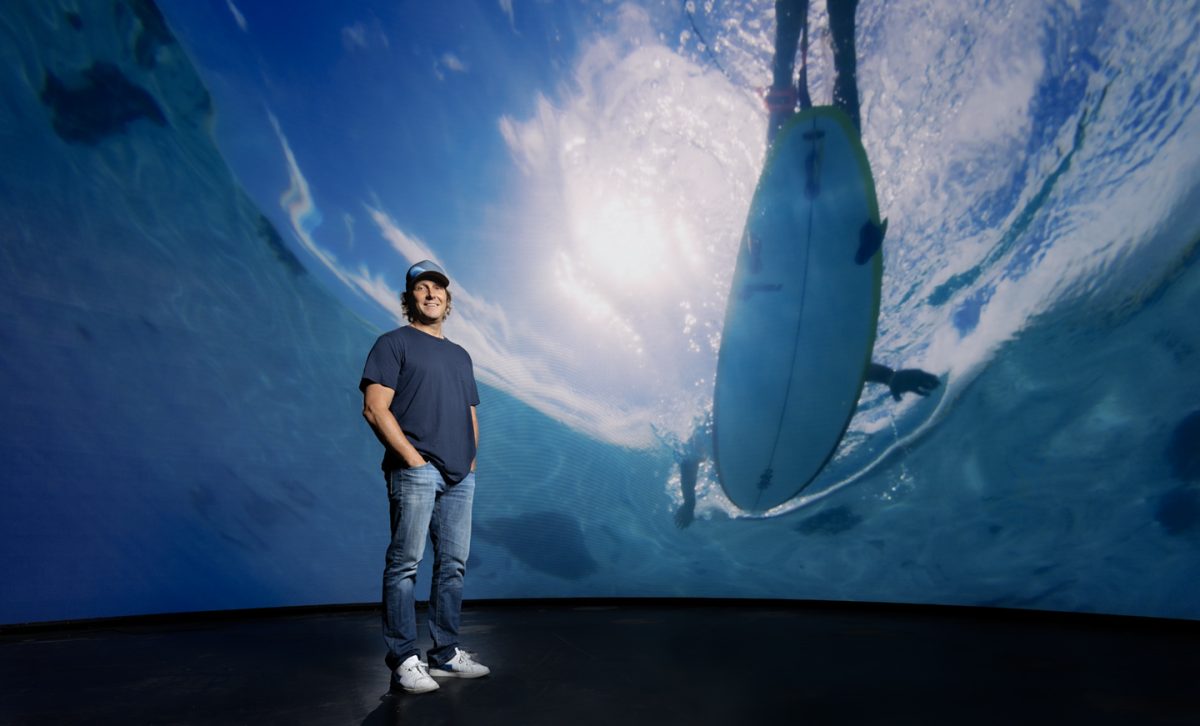
“Bo, what are you doing here?” Terry asked.
Bridges is one of those people who just seems to show up exactly at the right time and right place, hence his giftedness as a photographer. Terry grabbed Bridges by the arm and ushered him inside to the Cosm dome. NBA players, rendered 50 feet tall in 8,000k high-resolution, were leaping in the air above their heads. It wasn’t just visual, either. The squeaks of the players’ shoes as they cut across the court, the refs whistles, the non-stop chatter of players communicating on defense and trash-talking each other. It wasn’t so much like watching a game as it was being thrust right in the middle of the action.
Bridges was flabbergasted.
“What the heck,” he remembers thinking, “am I even looking at? This is so ridiculous.”
The second thing he thought, as his initial shock gave way to pure wonder, was that he wanted in. Anyone who has watched Bridges’ career knows he has the competitive gusto of an elite athlete — he’s always trying to up the ante, to do new and better things. One look at Cosm’s immersive technology and Bridges knew he had to figure out how to apply it to his work.
“I was just flipping,” Bridges said. “I’d just never seen anything like this.”
He told Terry he wanted to make something with this technology. The Cosm CEO told him they were looking for “creatives” like Bridges to continue expanding the boundaries of what they were doing.
“Alright,” Bridges said. “Well, let me think about it and get back to you, and we’ll go from there.”
So the adventure began. Two years later, the fruits of perhaps the most epic quest Bo Bridges has undertaken in the course of an action-packed three decade globe-spanning career will be unveiled this Saturday, March 15, at Cosm’s flagship entertainment center in Inglewood.
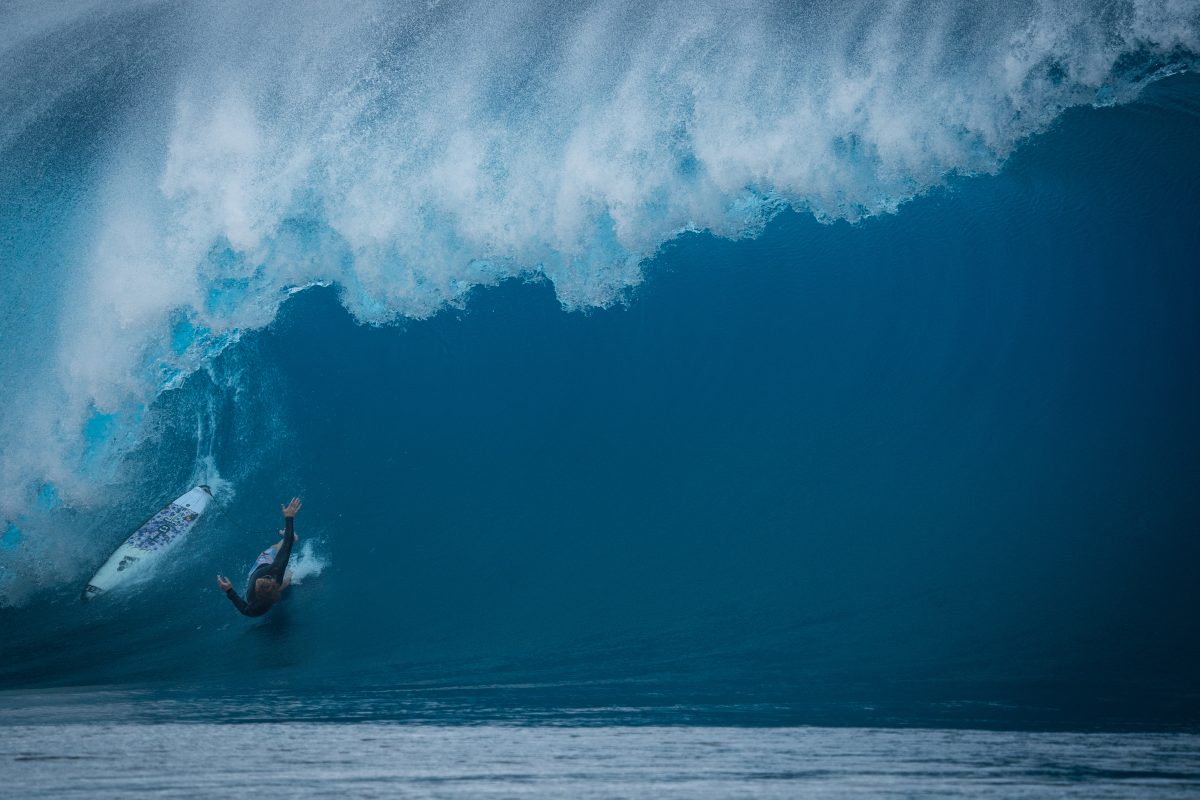
“Big Wave: No Room for Error” will be shown at Cosm’s immersive venue, an LED dome which is 87 feet in diameter and features a whopping 12k resolution.
The title, of course, refers to the big wave surfers whom Bridges documented taking on some of the world’s biggest waves — at Nazarene in Portugal, Jaws on the North Shore of Hawaii, and finally at Teahupoʻo, Tahiti. But Bridges likewise faced no room for error.
Bridges has shot snowboarders careening down backcountry mountaintop slopes, skateboarders in all arrays imaginable (he’s photographed every X Games since 1997), and some of the most storied big wave surfers at the most revered (and feared) waves in the history of surfing. Men’s Journal described Bridges as “the Indiana Jones of action photography.” But he’d never done anything remotely like this before.
In this, his first time as the director of a film, he found himself not only at the head of a crew of anywhere from 10 to 20 people out in extreme locations, but manning seabobs, jet skis, and even more frequently out in the big wave lineup himself, paddling with one arm while lugging an expensive, 35-pound camera, the highest-technology of its kind in existence. This was filmmaking that required the filmmaker himself to be immersed in the environment.
The result is that Saturday night at Cosm, viewers will for the first time be able to viscerally feel what heretofore only a few hundred people in the world have experienced — what it is like to ride a 40- to 60-foot wave. This is more than a surf film. It’s far more than “IMAX on steroids” as Bridges describes it, and in terms of live action exceeds anything thus far achieved at the cutting-edge Sphere venue in Las Vegas. “Big Wave” doesnt just show big waves, Bridges says. It takes you there.
“This is so much more,” Bridges said. “I can’t even describe it. People who come to see this will give an hour of their attention, and they will actually come into these places. We can talk about how I got this shot, or didn’t get it, but this is different. Come see this, because you are going to not only see it, you are going to feel it, all from the safety of a theater. We have a sound guy the entire time capturing the sound above the water, so you can hear the big waves crashing. And I had a mic underwater, so you hear the waves hit — that crack, snap, and popping sound.”
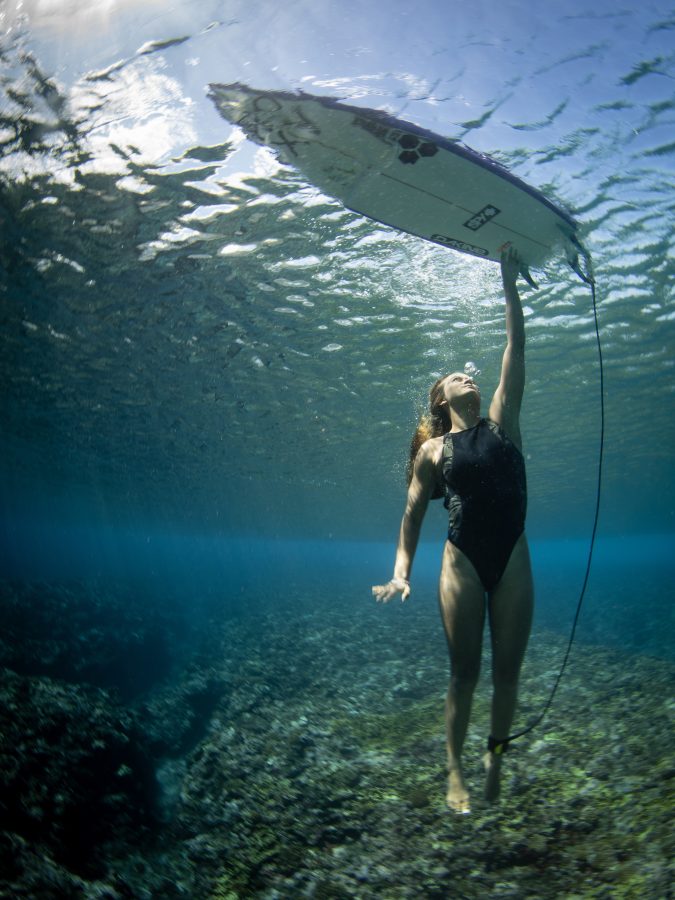
Bridges has reached a new apex, both for himself and his art form. A photographer sets out to capture an image that makes the viewer feel something. Few photographers have been more successful at this than Bridges, whose work adorns hundreds of homes and businesses and even public murals throughout the South Bay. But with “Big Wave” Bridges has made history, visually and experientially.
“It’s unprecedented, really,” he said. “I think shortly in the future, there will be cameras that will fit that void. But right now, people are having to work with multiple camera arrays, stitching scenarios — I mean, like the stuff at the Sphere in Las Vegas. No one has done what we’ve done in terms of shooting live action.”
The Life of Bo
The story of Bo Bridges has been oft-told. He grew up in Florida, a surfer and multi-sport athlete, and after studying to become a photographer, obtained his pilot’s license in order to shoot aerially for real estate companies. But his heart wasn’t in it, and he found his way to the first X Games in 1997, where he launched his career as an action photographer. He moved to Manhattan Beach in 2000 both for its proximity to good surf and an international airport. He has raised a family here, and owns a downtown gallery featuring fine art versions of his work.

After he successfully pitched Cosm on making a big wave film, Bridges began acquainting himself with the new equipment, doing test runs at Kelly Slater’s “Wave Ranch,” an automated surf pool in Northern California, just to get a feel for how this would work. He dropped into the North Shore for a bit but no big waves were popping, and so Bridges did what every big wave surfer does — he began watching global weather patterns online, looking for “purple blobs” indicative of storm systems that lead to epic surf in surrounding environs. Bridges was in contact with his buddy Garrett McNamara, the big wave surfer with whom he was nominated for the XXL Big Wave Award in 2004 for a photograph of McNamara on a 68-foot wave on the North Shore. McNamara caught a 100-foot wave in Nazaré in 2023, and so Bridges was paying special attention to that spot.
“This huge swell is getting ready to pop in Nazaré, so I called Garrett, like, ‘I need your help on this, because I don’t know that wave as well as you do, obviously,’” Bridges recalled. “If you want someone to help you out with something like this, he’s one of the go-to guys, and he’s been a friend for a long time.”
After Bridges and his team arrived in Nazaré, he began to comprehend just what an insane challenge he’d signed up for.
“We get there, and it’s pretty damn big, but the wind had turned while we were flying and it got really nasty,” he said. “So that day, we went out on jet skis and we tried to shoot, but it was like ‘Victory at Sea,’ just crazy, coming from all directions. And with that lens and the camera set-up — everything is shot with a fisheye lens, like a super wide angle, 180-degree field of view — so there is no room, no safe zone when you are shooting with these lenses. You have to be right there in the impact zone. You have to be underneath the lips [of the waves]. You have to be in the channel. You can’t shoot these waves from the safety of a cliff. That’s what made it so difficult. The entire movie had to be shot up close.”
This wasn’t the only problem Bridges identified. In his mind’s eye, he already had a picture of what he wanted this movie to look like. Nazaré is an iconic wave, big and dark and threatening. Most photos shot there are from above the little oceanside village. The wave often looks like a monster about to devour Nazaré. It’s dramatic, but there’s nothing pretty about it. Bridges is known for a wide variety of photographs, but like a guitar player whose tone you can recognize in a few notes, the common thread in his work is a sense of wonder and beauty. For this film, he was looking for epic beauty.
“Nazaré is a gorgeous little fishing town, but its water is dark, murky, and muddy,” he said. “Like, you can’t see your feet beneath you if you are sitting on a surfboard. It’s that murky. And the cliffs were dark, just gray and brown and red. The color palette wasn’t quite there for what I was going for.”
His thoughts immediately turned to Teahupoʻo, the gorgeous big blue wave in French Polynesia.
“I was thinking, ‘Man, this is really cool, but I think we need to focus on the South Pacific,’” Bridges recalled. “For the reason of just the eye candy that we wanted. Plus, Teahupoʻo is a consistent wave. It breaks almost in the same spot every single time. Whereas waves like Mavericks, Jaws, Cloud Break, and Nazaré all tend to move around quite a bit.”
Back home in Manhattan Beach, Bridges was back on purple blob watch. But disturbingly, nothing was happening. He didn’t have an endless timeframe or budget, and so he started casting his eye towards Tazmania and South Africa, looking for any wave that might pop. And it wasn’t like flying solo — he had to be prepared to book flights for a whole crew, on very short notice. He couldn’t be wrong.
Then, finally, late last spring, Teahupoʻo popped. He and his crew arrived to find crisp, beautiful, huge waves. “Everything started to come together,” Bridges said.
Which is not to say the work got any easier.
“You’re basically at the end of this road, and you’re lugging all this camera gear around, and there’s really no easy access to get anything from point A to point B,” he said. “You have to take Pelican cases, and the reason you have to have Pelican cases is because the boat that you’re shooting in can get completely rocked by the waves. Even in the channel where you think it’s safe, it’s never safe. You’re always aiming to bow the boat out to sea, and you’re always looking for those big, dark bumps that might swing wide and get you. And I’ve seen boats get completely tossed. We got hammered years ago where we were shooting the cover for a magazine. We got hit by a wave and it just engulfed the boat. And I did ruin a camera, but it wasn’t a big camera like this, just a still camera. It happens quickly, and there is no way to avoid it sometimes. So you are out there and it’s sunny and beautiful, and then there’s sideways rain, and then rainbows are popping, and then it’s sunny and beautiful again. It’s 80 degrees and 100 percent humidity and the sun is beating down and you are sweating. You are out there for the duration of the day, sun up to sundown.”
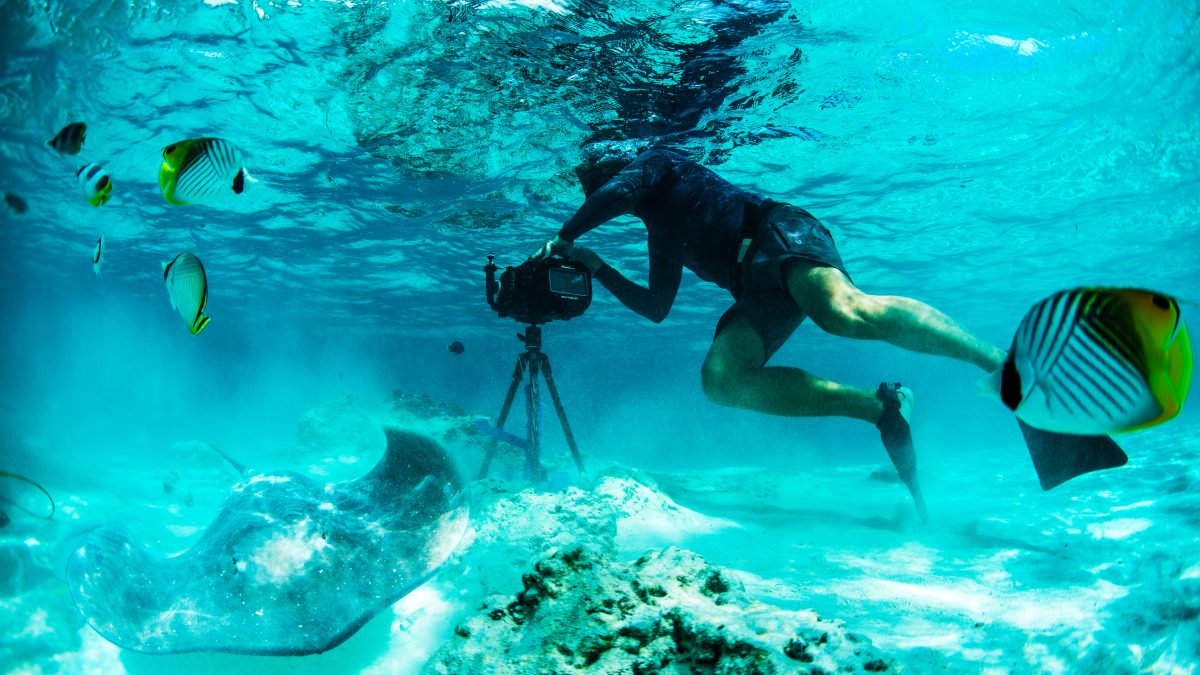
And that’s to say nothing of shooting from the water. In addition to shooting while swimming, Bridges deployed an array of “follow cams” to get the surfers from multiple angles, much as he captured surround sound. In trying to find the optimal way to shoot, Bridges realized that Seabob water sleds didn’t move fast enough to keep up with big waves.
“You think 15 mph is pretty fast and you’ll be able to keep up with the wave, but the reality is these big waves move much quicker, and you can’t keep up with them,” he said. “Sometimes, like the wave comes and you think you’ve got it, and it’s gone. It’s just tough. But we managed to figure it out. We mounted a camera on the Seabob, and we just did it.”
Shooting while swimming had its own set of challenges. The camera is heavy and yet has to be stabilized, in big water, to get a good shot, while at the same time making sure it’s not pointed skyward too long and develops condensation on the lens. Bridges and his other cameramen couldn’t look to the horizon for waves, but had to keep their eyes trained on the surfers — when the surfers began paddling furiously, that’s when they knew a wave was coming. The cameras, which had a four terabyte storage capacity, held a battery charge of about 45 minutes, and took a minute or two to power up — so the cameras basically had to remain on for fear of missing a fast moving wave. More than once, Bridges was at the very end of his battery when a big wave came crashing. So beyond worrying about his own welfare, he was always making time calculations. But the threat of getting crushed was also omnipresent.
“There’s just no room down there to screw up,” Bridges said. “There’s like two or three feet between getting actually annihilated by the pound of the wave and getting annihilated on the bottom by the razor sharp reef.”
The Teahupoʻo wave has a famously thick lip. It may be a beautifully perfect wave, but it is also among the most dangerous, a heaving slab that unloads its deep water swells violently on coral reef shallows. The entire equation, for a man swimming with a 35-pound camera and his eyes glued on a surfer in the curl of a wave the size of a four or five story building, makes almost no sense except for the sake of art, or maybe adrenaline.
“You know, you are swimming with one arm and two swim fins,” Bridges said. “You are swimming your heart out, as fast as you can, but you are going half the speed of everyone else, so you are kind of left in the dust when the big waves come.”
When Bridges set out on this journey, he wasn’t thinking so much that he was making a movie. He wasn’t looking for a narrative arc. But as he followed waves and surfers to the farthest and most drastic ends of the Earth, a storyline emerged. He ended up actually narrating the film, but he won’t say too much about the tale it tells. You’ll have to see it for yourself.
“I originally thought it would be like eye candy, just to have it on that screen, and maybe just evergreen material that you would watch in between a game, or at the end of the day,” Bridges said. “I didn’t really see it as the big-ticket, full docu-style movie we ended up shooting. I just wanted to show those big waves on that big screen, and just take people into that arena that I love so much, and just let them experience what it looks and feels like to be out there in the water. I thought with good sound design and music, people would want to come and see that all day long. But the more I delved into it, the more clear it became that I wanted to tell a story. And as I was working with the local team and surfers, that story just started evolving. It just came together really nicely.”
Surfers Heimiti Fierro, Eimeo Czermak, and Clement Roseyro figure prominently in “Big Wave.” Jet ski drivers Tikanui Smith and David ‘Chico’ Ariimoana also become part of the movie itself. Bridges has worked closely with big wave surfers for most of his career, but his admiration for what they do only grew with this experience.
“I have so much respect for all professional athletes, but surfers, they are a different breed,” he said. “They tend to just go out, challenge themselves for that day or that one wave, and then they’re just moving on to the next thing. They didn’t even ask to see photos. It’s like they just want to go experience something else, something bigger, something better, the next place.”
Which, of course, sounds a lot like Bridges himself.
“What else can we do?” he said. “I’m a filmmaker. We’re always chasing the next, best thing. Like, you’re not going to stop just because you nailed a perfect shot, right?”
“Big Wave: No Room for Error” premieres at Cosm on March 15 and will run from March 19 to April 24. See Cosm.com for more information. ER

